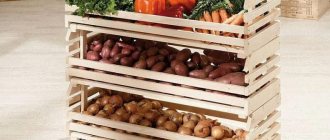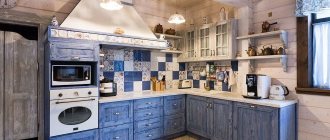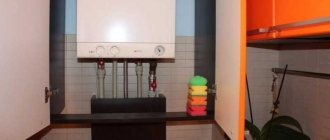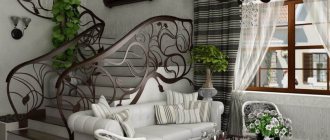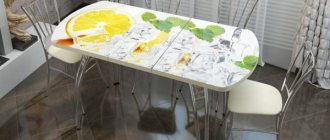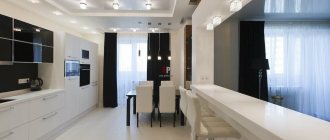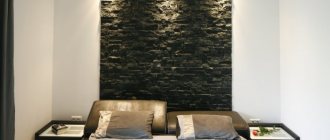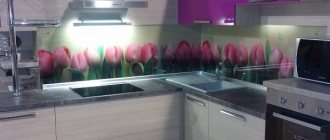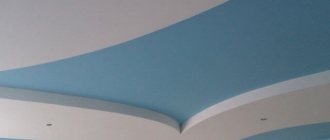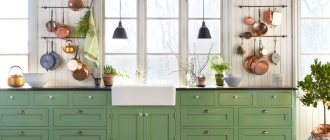Types of paints used for kitchen walls
The most commonly used paints are water-based and water-based paints. In turn, they are divided into silicone, acrylic, mineral and silicate. Their composition mainly consists of water, color pigments and polymers. Acrylic and silicone are most suitable for kitchens.
Oily
One of the most famous and long-standing representatives of what can be used to paint walls in the kitchen. It is produced on the basis of drying oil with the addition of pigment materials and fillers that promote viscosity and strength.
It’s easy to create a bright interior, the main thing is to choose a color you like
When choosing this type of paint, you should take into account that it does not allow air to pass through, contains volatile solvents, is difficult to remove, and at the same time, another type of paint composition cannot be applied to its surface. Alkyd paints are also not recommended for use in the kitchen due to their strong unpleasant odor.
Water-based
In order to make the design interesting, the wall in the kitchen is covered with water-based paint, also known as water-dispersion paint. It fits well on the surface, gives the wall a beautiful appearance, and has a greater variety of colors than oil paint.
It is also important that it does not emit toxic fumes, which makes it safe for use in kitchens
The only negative is that it is not resistant to water and exhibits the ability to be washed off little by little under its influence. This leads to dulling of the surface.
Carefully! Choosing this type of coloring composition may not be economically viable due to the need for frequent touch-ups
Acrylic
To paint the wall, you can use paint based on acrylic or latex. The surface covered with it can be washed as much as you like; it is absolutely not afraid of water and various household detergents. It has excellent vapor permeability, condensation does not form under it, and it lasts much longer. A big plus is the ability to hide microcracks if their size is less than 1mm, it lies flat. Used on almost all types of surfaces.
Modern manufacturers produce various types of them:
- acrylic (based on acrylic resins);
- latex (with rubber in the composition);
- latex (with an acrylate binder).
Rubber forms an elastic film after drying, which makes the coating durable and stable. The addition of an acrylate binder improves all technical characteristics of the paint and significantly increases the service life, including color fastness. Moreover, it is the most expensive of all existing coloring compositions.
Acrylic paint - bright interior and easy care
Painting the walls in the kitchen
All walls in the kitchen for painting must first be prepared, then primed and only then painted. Only such a sequence will give the expected result and can guarantee the quality of all work.
Preparatory work
- To begin, the walls for painting in the kitchen must be thoroughly cleaned of old materials.
- If necessary, they can be plastered.
- After this, you should use putty, which will give the surface ideal evenness and a uniform color, which will subsequently save dye.
- After the putty has dried, it is sanded and the walls are wiped with a damp rag.
Advice! When applying putty, it is necessary to use various tools to measure the plane of the surface and good lighting. This will help avoid the appearance of unevenness.
The result of poor surface preparation and savings on primer
Primer
Whatever the options for painting kitchen walls, they all require a primer.
- It serves as a binding material between the wall, putty and paint.
- Significantly reduces the absorbing properties of materials, which significantly saves dye.
- Serves as a good fixative.
Advice! It is best to choose an antibacterial primer with a high penetration number. This will protect the walls from mold, which is very important in this type of room.
Mixing paint and color marker
Preparation of material
Regular kitchen wall paint is sold as a white base color. Therefore, if desired, you can add a special color to it, which will give it the desired color. It is worth noting that painting kitchen cabinets and walls can be done in one color, but only in different shades.
Therefore, there are several rules for preparing the dye.
- First of all, you should use the entire volume of the white base to give it the desired color (see also what color to paint the kitchen). This is due to the fact that it is almost impossible to get the same shade in two different containers.
- The color must be added gradually, thoroughly mixing.
- Before you start painting the kitchen walls, you should apply a small amount of paint to a certain area of the prepared surface and let it dry. This way you can really imagine what the work will look like and make adjustments to the composition of the material.
- When working, you should use a special attachment on a drill, with which you can thoroughly mix the dye with the color.
Advice! Before starting mixing, it is recommended to leave a small amount of white base so that you can slightly lighten the tone if there is an excess of color.
Painting
It is worth noting that painting kitchen walls is done in the same way as any other surface. It is necessary to work in one direction when applying the first layer, and change it when applying the next one. This technique is used when using any tool.
Advice! Usually just one coat is enough, since after priming the dye adheres well to the surface. However, it is recommended to use several layers to achieve a long-lasting effect.
Painting walls with a brush
Tools
For different colors, the kitchen requires the use of different tools.
- Roller – used for applying dye over large areas. It makes it possible to make uniform layers and allows you to control the consumption of materials.
- Brush – makes it easier to reach hard-to-reach areas. At the same time, complete painting of the walls in the kitchen can only be done with the help of this tool. However, using it wastes a lot of time and effort.
- The spray gun is very effective on large volumes, but when working with it it is necessary to use personal protective equipment. Also, before working with it, you should cover all non-paintable parts, as recommended in the video instructions, which are presented on our portal.
Advice! It is best to use a roller in combination with a brush. This will allow you to paint hard-to-reach places well and apply a minimum amount of effort over large areas.
Painting walls with a roller
Acrylic paint is the best choice for your kitchen.
Home > Architecture and Design > Acrylic paint is the best choice for your kitchen.
When it comes to kitchen renovations, many questions arise about wall decoration. It is known that the kitchen is one of the most “unfavorable” places in terms of service life. Constant temperature changes (due to the operating stove), high humidity, various odors... If you decide to paint the walls of the kitchen, then, unlike tiles or wall panels, paint is the most cost-effective option. The range of paint and varnish products is amazing in its diversity. I would like to talk about working with acrylic paint, as I myself have used its advantages. Waterproof acrylic paint is suitable for use on any surface: brick, concrete, plaster, drywall, plaster, structural wallpaper and fiberglass. It penetrates deeply into the material (therefore it is especially good on “porous” surfaces) and does not peel off. When choosing acrylic paint for the kitchen, pay attention to such properties (you can read about them on the packaging) such as: fire and explosion safety, light resistance, environmentally friendly components, resistance to mechanical action and tolerance to wet cleaning. In some types of acrylic paint, specialized silicone, antibacterial and non-stick additives are used to obtain unique performance properties of the paint for specialized applications (for example, in the kitchen). The surface painted with this paint is silky-matte and “breathable.”
Before painting, you need to pay great attention to preparing the walls. Carefully remove the remnants of the previous coatings (for this it is convenient to use special attachments on a drill), be sure to check all the corners - they must be exactly 90 degrees, otherwise the kitchen furniture will not stand up straight
To level the walls, use a special putty for wet rooms (I used latex). Don’t skimp – the smoother the walls, the more impressive the paint will look. After the putty has completely dried, prime the walls. This will help the paint lie flat and prevent mold or mildew from forming on the walls. Before starting work, mix the paint thoroughly until a homogeneous mass is obtained; if it thickens, it can be diluted with water, but the volume of water should not exceed 5% of the total volume of paint. You can paint the kitchen walls with a roller or brush. (the roller is very convenient, as it allows you to apply the paint in an even layer without streaks, covers a large area, and the paint, due to its thickness, does not run off). Drying time is 2 hours, after which you can apply a second layer. Acrylic paint acquires all the properties declared by the manufacturers within 7 days. I hope you will be satisfied with the result and the kitchen will become one of the most comfortable places in your apartment!
What tools to use
First, let's figure out how to paint the kitchen. To do this you need the following tools:
- Brushes;
- Painting film;
- Wide and narrow paper tape;
- Narrow and wide spatula;
- The scrapers are triangular and have a cutout for a roller;
- Plastic bucket;
- Tray or grid corresponding to the roller;
- Rollers (large, small, narrow);
- Bar for mixing paint;
- Sandpaper, mesh and pen, tool for sanding walls;
- Silicone gun:
- Drill with mixer for putty.
- Level (to check the evenness of the walls)
Painting tools
The width of the rollers should be from 20 to 32 cm, the length of the pile should be from 8 to 12 mm. A foam roller is not for you. For hard-to-reach areas you need a radiator roller.
You need two brushes. One is 50 cm wide, the other is 35 cm. For large areas you need a 75 cm brush. For water-based paints we take nylon brushes, for alkyd ones - with natural bristles. You will also need a curved battery brush.
You can check the paint color on a piece of paper
To choose a paint, try coating the paper first, wait until it dries, and judge the color. The paint composition and putty must be from the same company. This determines how quickly the wall dries, how resistant it will be to mechanical damage, and its appearance.
Advantages and disadvantages of acrylic paints
Acrylic painting materials are highly attractive and come in a variety of shades.
If you are interested in the best way to paint the walls in the kitchen, you must definitely pay attention to acrylic paint. Such compositions perfectly combine the advantages of polymer paints and water-based analogues:
- Durability. When applied to the wall, such paints do not fade for a long time.
- Attractive appearance. Such compositions are distinguished by a variety of colors and the possibility of application in a thin, even layer.
- You can carry out wet cleaning.
- High wear resistance.
Why paint and not wallpaper?
Wallpaper is traditional for living spaces. They look good, and gluing them to the walls is not a big problem when doing DIY repairs. In addition, this type of decor successfully hides small defects on the walls: small cracks, roughness, and the like. However, wallpaper has one property that makes it unsuitable for use in kitchens: it is resistant to high humidity, which so often occurs in the kitchen during cooking.
Anyone who has independently repaired and removed old wallpaper before gluing new ones knows well the traditional method of removing old unnecessary covering. Old wallpaper is generously moistened with water, as a result it swells and the adhesive composition softens. Thanks to this, with good moisture, they practically fall off the wall on their own.
That’s why, having hung wallpaper in the kitchen during renovation, you can one day discover that, under the influence of constant high humidity, it has become swollen and covered with bubbles. It’s good if after drying they settle into place and their previous appearance is restored. Otherwise, you will have to do the repairs again, which is wasted time and money.
Based on these considerations, painting walls in kitchen areas is preferable to wallpapering.
Let's take a closer look at how to paint the walls in the kitchen, choose the materials necessary for this, as well as the types of paints suitable for performing such work.
Related article: Using pink wallpaper in the kitchen interior
Types of water-based paint
Due to additives, water-based paint can be divided into several categories. It all depends on what material is added to the composition. There are several types of paint that are ideal for kitchen walls:
- acrylic;
- latex;
- alkyd;
- silicone.
Acrylic-based paint is relatively cheap, but is not particularly popular among craftsmen. The thing is that the composition is quite elastic and durable. Using acrylic paint you can create a velvety matte surface. The walls will withstand wet cleaning without any problems.
Latex products are more expensive and of higher quality. Due to the latex content, they are resistant to adverse kitchen conditions. After application, a durable thin film is formed that protects the wall from moisture and abrasion. The paint is washable, but slightly inferior to acrylic in vapor permeability.
Alkyd compositions are not very popular, but they are also suitable for kitchen walls. They are highly wear-resistant, resistant to sudden temperature changes, tolerate moisture well, and have a rich color. In addition, anyone can apply the composition, and the mixture consumption is small. But there is a big disadvantage of the paint - it is based on a solvent, so it cannot be called environmentally friendly. And the fire safety of the material is poor.
And finally, a silicone-based composition. We can say that all the positive qualities from other paints were taken and assigned to this particular type. The paint is washable, wear-resistant, dries quickly, etc. There are no disadvantages
Unless you take into account its price. She's the tallest
Although the stingy, as they say, pays twice, or even three times. Therefore, you should not skimp on the quality of material for the kitchen. But still, what kind of paint to choose is entirely up to you.
Advice! If you doubt the quality of the material, you can conduct some experiment. Apply the composition to the surface and place it in water for 24 hours.
When the sample looks perfect, without damage or defects, the paint repels water and washes well. If the material has peeled off, become blistered, or washed away, it should not be used.
What should the wall paint be?
The paint that is planned to be used for the kitchen deserves special attention.
It is important that she:
- contained a wide variety of colors and easily represented not only the main tones, but also their various shades;
- cover the surface tightly, neatly, evenly;
- was resistant to moisture and household detergents and did not wash off;
- did not change under the influence of ultraviolet radiation (for example: white - did not turn yellow, and colored - did not fade);
- was not accompanied by a toxic odor when dyeing;
- was durable;
- made the surface beautiful and gave its notes a special appeal.
Choosing wall color in the kitchen
When choosing the color of the walls in the kitchen, you must take into account that it determines the style of the room as a whole. A well-chosen color scheme can visually increase the area of the room.
The color of the kitchen walls should be harmoniously combined with the color of the furniture in the kitchen. But the color of the furniture and the color of the walls should not match, in which case they will merge and the kitchen will look monotonous. To get a more saturated shade, the surface needs to be painted in several (about 2-3) layers.
It is also worth considering that matte paint will look darker on the wall than in the package, while glossy paint will look brighter. But do not forget that after drying the final color will fade a little.
It is known that different colors have a certain effect on the physical and psychological state of a person, as well as on the perception of the interior as a whole.
For example.
- The color yellow is associated with the sun. It will create a cozy atmosphere and promote a healthy appetite;
- Orange color stimulates the appetite in the best way, but its abundance in the kitchen interior can be irritating.
- Red color promotes excellent appetite, but can cause a state of discomfort.
- White color is neutral. It will create the feeling of a sterile room, so it is better to use it in combination with others.
- Blue color is not associated with food and suppresses appetite, so it is rarely used in kitchen interiors.
- Cold tones of green, purple, gray colors reduce appetite. These color schemes are recommended for those who want to lose weight.
- Olive color will fit perfectly into the interior of any kitchen; it creates a feeling of coziness and comfort.
When creating an interior using painting, you can divide the kitchen into functional zones by using different colors.
You don't always have to paint your kitchen walls the same color. You can use masking tape to paint stripes, checkered patterns, and various other geometric shapes in different colors. You can also create a decorative pattern using stencils. A wealth of imagination will help with this.
Ideas for combining wall colors and furniture
If the set is made in bright, eye-catching colors, then it would be advisable to paint the walls in calmer and neutral colors or vice versa. For example, brown, green, orange or blue wall colors are perfect for a white set.
The photo shows a white kitchen set in combination with blue walls.
You can also create a bright color accent by decorating the apron in the opposite color of the kitchen set.
Types of coating
It is recommended to use compounds intended for interior work. When choosing materials for painting walls in the kitchen, preference should be given to moisture-resistant types. The most commonly used are water-dispersion, latex and alkyd compositions; epoxy and polyurethane options are allowed.
Due to the high price of high-quality paint, a choice is often made in favor of cheap types. Such a decision may negatively affect the quality and timing of repairs. You can save on preparing and finishing the walls and do the work yourself, but it’s still worth purchasing paint from reliable manufacturers.
Water-based
The paint is produced with the addition of mineral particles, polymers and tinting particles. After application, it dries quickly, leaving a thin polymer film of mineral components. Main advantages:
- easy and uniform application to the prepared surface;
- absence of a sharp chemical odor during drying (painting can be carried out even in an unventilated room);
- quick drying;
- with proper application and proper operation there is no risk of peeling;
- environmental safety (the compositions do not contain toxic components that cause allergies and other disorders);
- prostate in care (it is possible to clean dirt from the surface even with a dry cloth);
- increased resistance to alkalis.
The advantage of water-based paint is that high-density compounds fill cracks and cracks, masking them.
You can only work with water-based emulsion at room temperature, because at 0°C it thickens and freezes.
Alkyd
Alkyd paint for walls in the kitchen will look aesthetically pleasing and attractive. After drying, a beautiful glossy surface will be created that will not lose its shine during long-term use.
The advantage of the compositions is that they are not afraid of contact with any cleaning agents. Due to their durability, alkyd paints are used to treat walls and floors. The main component of the coating is resin, the production of which uses soybean, linseed or tall oil.
Advantages of alkyd paints:
- rich and bright colors that will not fade over time;
- high wear resistance;
- long service life;
- easy to clean.
Minus: surfaces coated with these compounds do not “breathe”.
Epoxy
For painting kitchen walls, epoxy compounds are the most preferable, but compared to other finishing materials, they are expensive, which is why most people refuse to use them.
Epoxy paints are characterized by increased resistance to moisture, which is the most important criterion when it comes to using the composition in the kitchen. The base is epoxy resin. The compositions have the following advantages:
- long service life;
- the composition adheres tightly to any surface, including concrete and plastic;
- the coating is not afraid of water, contact with chemicals and mechanical stress;
- the film created on the surface easily tolerates loads;
- to achieve an even and dense color, it is enough to apply the composition in one layer;
- high resistance to gases, alkalis and acids.
Weaknesses of the epoxy composition:
- increased susceptibility to ultraviolet rays;
- with strong heating, the coating may turn yellow;
- long drying (about 24 hours);
- unpleasant odor, so the room must be constantly ventilated during operation;
- The composition is applied only at temperatures above +15°C.
Acrylic
The most important advantage of the compositions is the wide range of colors. The binder component is an aqueous suspension of synthetic resins. The composition contains polymers, methyl, ethyl and acrylic. The demand for acrylic paints for walls in the kitchen is due to the following advantages:
- Versatility. The material is used for processing any surfaces (plywood, brick, concrete).
- Environmental friendliness;
- Quick drying (a thin layer dries completely in 2-3 hours).
- Wide choice of colors;
- Dirt will not accumulate on walls treated with acrylic, so cleaning will only have to be done as needed.
The main disadvantage of acrylic paint is its high cost and a large number of fakes.
The paint does not tolerate contact with aggressive chemicals.
Combined coloring options
Here we will not talk about painting technologies, but about how in the design the walls are divided into zones of two different colors. There are 10 original and winning approaches.
Dividing the wall horizontally
One part of the wall area from the floor is painted with one color, the part that is higher will be painted with a different shade. The border is most often set at about a third of the height of the wall from the floor. But you can show your imagination and draw the line somewhere else. For example, you can divide the wall in half or make the lower part larger. Sometimes designers create a border even under the ceiling.
The traditional way of painting is to divide the wall into two parts below the midline. Painting wallpaper or a wall in this way is ideal for various interior solutions - this is true for both classic and modern style trends. The process of painting walls in two colors in apartments with walls divided horizontally allows you to get the effect of panels that are usually installed at the bottom of the walls.
In this case, the border between two colors is formed using moldings or decorative elements.
How to paint? First, the wall is painted in light colors. After the paint has dried, mark and draw a line - this is the future border. Painting tape is placed below or above this border. It should be applied where it has already been painted. Then the area above or below the border is painted in the 2nd color. The tape is carefully removed.
Related article: Color palette for interior decoration (+50 photos)
Colored inserts
This technology also imitates panels. First, the wall is painted in one of the selected colors. When the paint is completely dry, mark the work surface. Adhesive tape is applied along the drawn lines. The result will be square or rectangular areas - they are painted over with a darker color on the inside. Then the tape must be removed before the paint dries. By showing imagination and creative abilities, you can apply other original solutions.
It should be remembered that this method of finishing is ideal for a classic - an entrance hall in the Baroque style or another glamorous style.
Accent walls
This approach makes a bold statement without the risk of oversaturation. Most often, neutral or light colors are used to cover three of the four walls in the room, and the last, fourth wall, will have a different shade. The color can be anything - very restrained or rich and bright. It all depends on the desired design effect. Naturally, there is no strictness here. You can paint not the entire wall, but only a part. For example, you can make a wide vertical stripe.
Gradient power
Everything here is similar to accent coloring. The entire surface in the room is covered with one selected color, and one part should be different. But the secret is that they do not use different colors, but tones of the same color differ in saturation. The result is a gradient. Designers often use up to four tones - the hallway is painted in one shade, the bedroom in another, for the walls in the kitchen a third color is used.
Horizontal stripes
This is a very simple, yet effective way to get an original wall. The technology is simple: first, the entire work area is painted with one color. When the paint is completely dry, mark the lines - these are the lower and upper boundaries of the large stripe. Tape is placed along the lines and painted with a different color, but only inside the lines. Experts recommend peeling off the tape while the paint is still wet.
This option is ideal for corridors and hallways. The strip will visually make the ceiling lower, and the entire room will become a little wider and more spacious.
It is enough to use two or three tones and the wall can easily turn into striped. It must be said that this process is quite labor-intensive, but the result is worth the time spent. The easiest way is to make a wide strip - in this case, you will need less work with tape, and the result will look neater. A wide stripe looks softer than a narrow stripe.
Complex shape
Coloring using two or more colors may vary. The most bizarre options will do. For example, the border between two shades can be in the form of an arc, wave or zigzag. The second color can be placed on top of the main color in circles, ovals and various geometric shapes.
Related article: The sophistication of gray is the background for a bright interior
The interior is a fantasy. To get a truly stylish apartment, you just need to think, and then take the appropriate colors, roller or brush and turn a boring apartment with gray walls into a dream home.
It’s actually easy; with these secrets of painting a wall in two colors, your apartment design will be as original as possible. Painting walls or wallpaper in two colors is an opportunity to get away from imposed standards, so you shouldn’t wait long - your dreams should come true.
Gradient painting of walls (2 videos)
Options for painting walls in two or more colors (42 photos)
Preparing the room before painting
Materials are being calculated. In this case, information on the consumption of paints and varnishes provided by the manufacturer and the surface area of the walls or floor are taken into account. Brushes, rollers, and spray guns are used for painting. The choice is made taking into account the type of paintwork
Pay attention to the quality of the surface when choosing a tool. If there are no surface defects and a roller is chosen as the tool, then the length of the pile should be no more than 12 mm
Determine the most suitable color scheme. At this stage, the style direction of the design and the type of finished surface are taken into account: plaster, wallpaper that can be painted, decorative brick, etc. Often a complex paint and varnish application scheme is chosen (a combination of paint of different colors, a combination of textures).
The kitchen area must be cleared of interior items. Large furniture is protected with plastic film. Work is carried out in a ventilated area. Preparation includes the following steps:
- removal of old coating (if necessary);
- leveling the surface using plaster;
- grinding is performed to remove residual mortar;
- padding.
Tool:
- spatulas of different widths;
- brushes;
- rollers;
- construction mixer for preparing mixtures;
- sandpaper;
- Sander;
- grater.
Painting walls in the kitchen and its benefits
beige walls in the kitchen interior
The paint is great for the design of modern kitchen interiors. With its help, a magnificent, uniform and smooth surface is created, which acquires a beautiful gradation in the light rays. The main advantages of kitchen paints are:
- Water resistance. This is the main parameter for compositions planned for use in harsh kitchen conditions.
- Possibility of tinting.
- Environmentally friendly.
- Easy to apply.
- No irritating odor.
- Fire safety.
- Breathability. This condition also applies to mandatory indicators. Pathogenic microorganisms will never settle under layers of such paint.
- High-quality adhesion. The paint should adhere well to the surface, not crack or peel.
- Almost instant drying.
- Durability.
- Correct price compared to the cost of other finishing works and materials.
How to prepare a wall for painting
To make painting walls easy and the end result to please you with its appearance, you need to perform several mandatory operations.
First of all, you need to rid the walls of a layer of old paint or wallpaper, if any. They are pre-moistened with water, as already described above, and then removed.
If the old coating is made with water-based emulsion, which is in good condition, then it can be left. In this case, new paint is applied on top.
Old paint (oil or alkyd enamel) must be scraped off. This work is easier to do with a spatula and a hair dryer. Using a hot stream of air from a hair dryer, the old paint softens and swells. This then gives a good opportunity to remove it relatively easily with a spatula.
Related article: Wood plaster: finishing features and its technology
After such work, the wall surface needs to be given an almost perfectly smooth appearance. This will require putty. To remove relatively large defects, use a starting putty; for small irregularities and finishing work, use a finishing putty.
After the putty has dried, it can be treated with a fine-grained abrasive painting mesh. With its help you can achieve a perfectly smooth surface.
A small detail that will be useful for improving the quality of the repair: before applying putty, it is advisable to treat the wall surface with a deep penetration primer. The same primer, the brand of which will depend on the type of paint chosen, should be applied to putty walls. The primer improves adhesion to the surface to be painted and thereby extends the service life of the coating. After application, the primer must dry, then you can proceed directly to painting.
Types and methods of painting the kitchen
The paint must be brought into the room a day before the process. Don’t forget to pre-glue the cornices, switches, baseboards, and window slopes with mounting tape. Furniture with floors and doors must be covered with construction film
It is very important not to take any breaks while painting. Painting a wall in one step
It is better to paint starting from the window
- It all starts with painting all the internal and external corners, starting from the window side.
- We paint corners, baseboards, radiators and other surfaces that a roller cannot handle. It is better to choose heat-resistant paint for batteries, and varnish for skirting boards.
- To ensure that the surface is painted evenly, roller the board or paint mesh before the procedure to remove excess paint.
Don't forget to take out the furniture and cover everything with foil.
- The paint is applied in two layers. For the first one, dilute it slightly, for the second there is no such need. It is better to start painting the walls from the window side.
- Visually outline a section of the wall about two meters wide. Paint for a roller is poured into a tray, for brushes - into a tall bucket. Using a brush 50 cm wide, paint the contours of the square in one layer, preferably from top to bottom. Don't forget to paint the corners. Next we work with a roller. It is soaked and rolled on the surface of the pallet to remove excess paint. The technique you use with a roller depends on what kind of paint you have.
If it is water-based, then the procedure is as follows:
- We paint the selected square with W-shaped movements starting from the ceiling and to the baseboard;
- We do not press the roller very hard and try not to rotate it;
- We paint the square with leisurely up and down movements, distributing the paint evenly.
You can also apply one layer horizontally, the second vertically. This is a “cellular application technique.
We use alkyds a little differently:
The first layer is applied with quick strokes; The second - with the W-shaped movements already familiar to us; It is important to apply the next layer after the first has had time to dry.
There are several rules for successful painting:
- First, the pressure on the roller or brush should be light rather than strong;
- Secondly, immediately after painting, remove the masking tape;
- It's better to start with the window.
If you are painting with your own hands for the first time, then start from the area where the furniture will stand. She will definitely hide your mistakes from prying eyes. It is better to paint slopes with corners with a smaller brush.
Also read about this! What color to paint the kitchen - recommended colors
Let's start painting
The main secret to great painting is painting the entire wall at once.
Don’t leave half a wall “for tomorrow” or even for a couple of hours. This is an ironclad rule.
To achieve maximum uniformity of the painted coating, the selected area should be painted in one approach.
To make the process of painting walls more clear, we offer you a short video.
Based on this rule, you need to calculate your strength and time in advance.
Step by step guide on how to paint a kitchen wall:
- 1 The paint will need to be applied in two layers.
For the first one, you can dilute it a little (5-10%) and mix thoroughly.For the second - dilute only as recommended by the manufacturer, otherwise use the original consistency, after mixing thoroughly;
- 2 You need to start from any edge (preferably from the window) and visually outline a section of the wall 1.5 - 2 meters wide;
- 3 It is better to pour paint for brushes into a separate high container, for a roller - naturally, into a tray, but not to the fullest;
- 4 Next, take a brush (50 mm) and paint the contours of this area in one layer: below - at the baseboard, above - at the cornice;
- 5 If you start from a place where there is a corner, then do not forget to paint over it with a brush;
- 6 Now take the roller and carefully dip it in the tray (pallet) so that it is well saturated with paint over its entire width;
- 7 Next, roll it a little on a special ribbed surface of the pallet to get rid of obviously excess paint;
- 8 The technique of using a roller when painting a wall depends on the type of paint being applied:
Water-based paint (acrylic, silicone, latex) should be applied as follows:
- first make several smooth W-shaped movements from the ceiling to the baseboard throughout the entire area covered;
- then move up and down with leisurely movements, evenly distributing the paint and tightly covering the entire surface;
- try not to put too much pressure on the roller and get the hang of it so that at the end of the movement the roller does not rotate, as this can lead to paint splashing;
- There is also a “cellular” technique for applying water-based paint: the first layer is applied vertically, exclusively with down-and-up movements, and the second - horizontally.
- this will allow you to paint walls with water-based paint without streaks;
Alkyd enamels are a little longer and more difficult to apply:
- The first layer is applied with a brush using the retouching technique, i.e. quick strokes from side to side;
- the second is already applied with a roller using the W-shaped or “cellular” method discussed above;
- important: before applying the next layer, make sure that the previous one has already dried.
Surface preparation
washable paints should be selected for kitchen walls
The walls must be prepared for painting, and the better this stage of work is completed, the better the final result will be. So what needs to be done and in what order?
- The kitchen walls should be cleaned of dirt. You need to be especially careful when dealing with traces of fat. The old finish is removed, along with the crumbling plaster.
- Browse the space that opens. There should be no signs of mold or mildew. If there are any, then these areas are cleaned mechanically to a clean surface, and then covered with an antibacterial composition. The resulting potholes are filled with gypsum or, less commonly, cement mixtures.
- Painting the walls in the kitchen will be ideal if the layers lie on a completely smooth surface. Such a surface can be achieved using acrylic putty. Spread it evenly over the wall, let it dry and sand it well.
- To improve adhesion to the paint, the puttied wall is treated with a primer and left to stand for the time recommended in the instructions. Now the wall is completely ready for finishing work.
Process description
Let's look directly at the painting process itself. Let's pay attention to how to paint the walls in the kitchen correctly to ensure long service life and a pleasant appearance.
First of all, you need to decide on the choice of tools. These can be brushes or rollers. Brushes can be taken in different widths, with natural or artificial bristles. The main thing in choosing a brush is the ease of working with it and the quality of paint application. It is not recommended to immerse the brush completely in the paint can, but only halfway. Otherwise, the paint will drip from the brush and form streaks on the wall. Excess must be shaken off.
Rollers also come in different sizes: small, medium and large. The pile on the rollers can be made of natural or artificial fur. The length of this pile, which determines the appearance of the coating and its roughness, also varies. For rollers, you will need a tray or tray, with which the paint is evenly distributed over its entire surface.
It is advisable to cover the floor in the kitchen with film or cover it with old newspapers. This will make your subsequent cleaning easier.
Related article: Staircase to the second floor. Rules for staircase construction
The baseboards and ceiling at the border with the walls must be covered with paper masking tape. It will prevent you from accidentally applying coating where you shouldn't.
If you are doing your own repairs, you need to know that to ensure even coverage, you need to apply at least two coats.
Each layer is applied perpendicular to each other, for example, the first vertically, then the second horizontally. This technology is applicable for both brush and roller work. Those places where it is impossible to reach with a roller are pre-treated with a brush, for example, corners and walls behind heating radiators.
Each type of paint may have its own technological features, which are indicated in the instructions for use. For example, the need to wait until the previous layer has completely dried before applying the next one.
It is customary to start painting from the top, from the ceiling, and cover the entire wall at one time. This will ensure even coverage.
